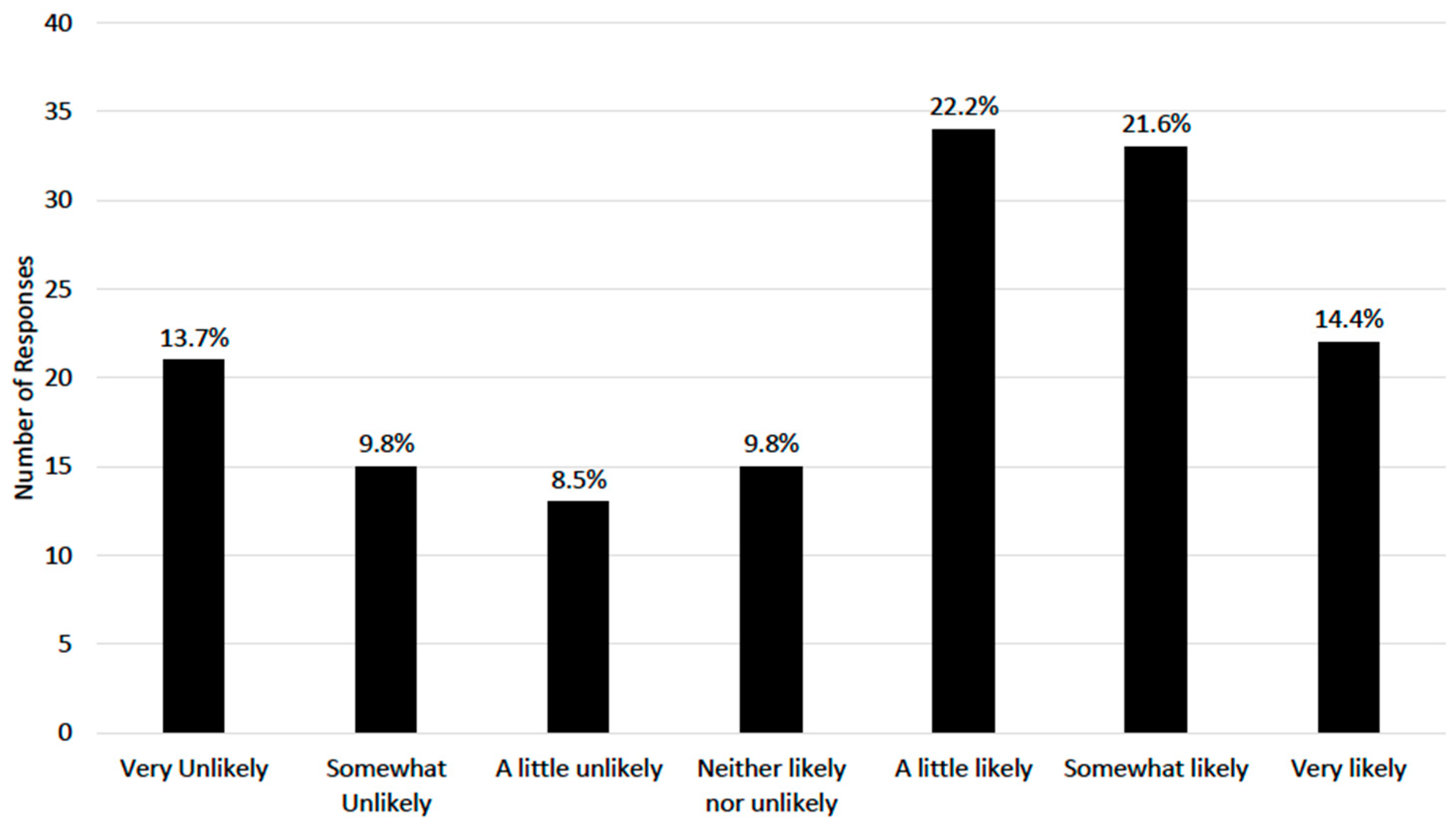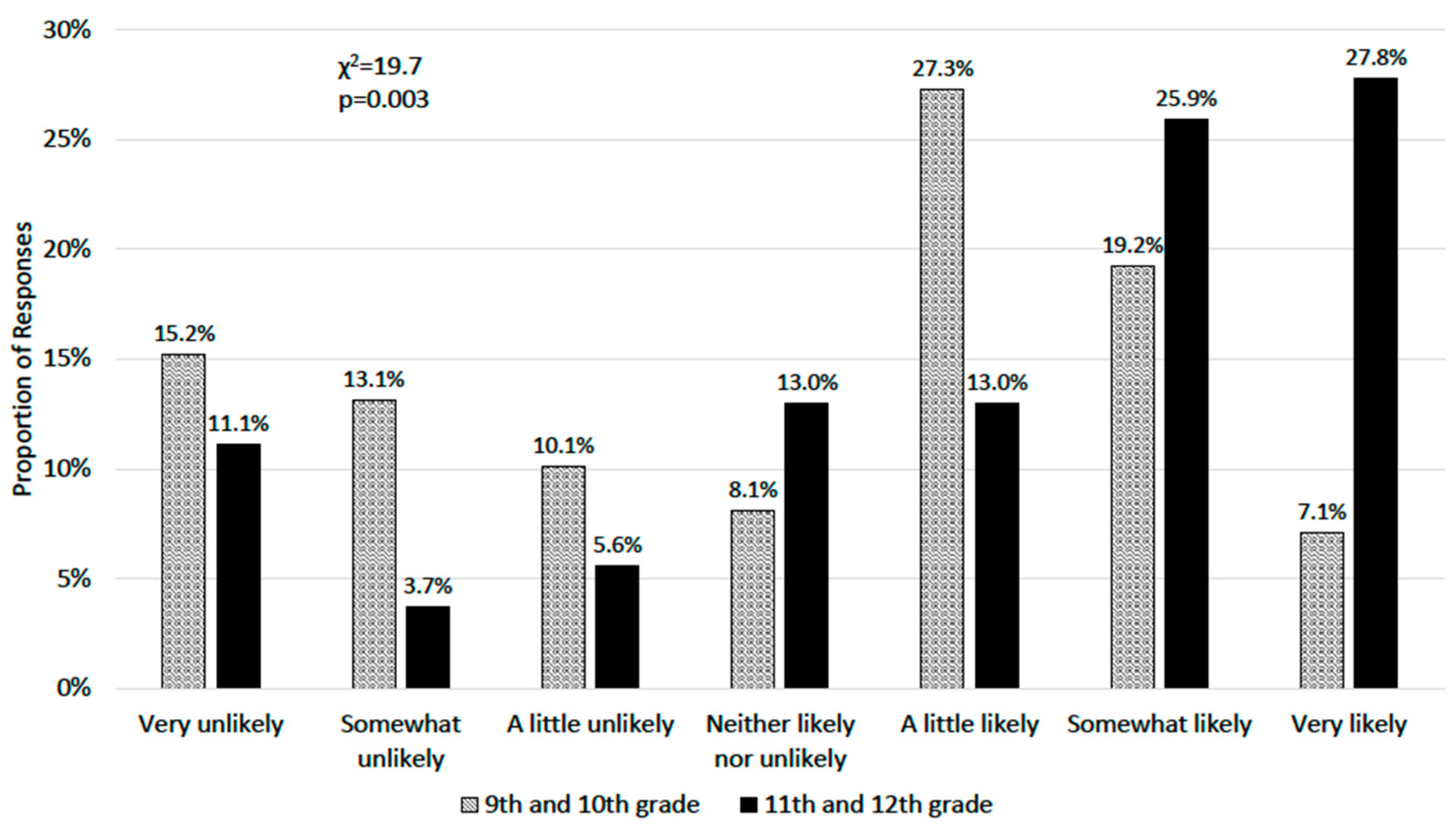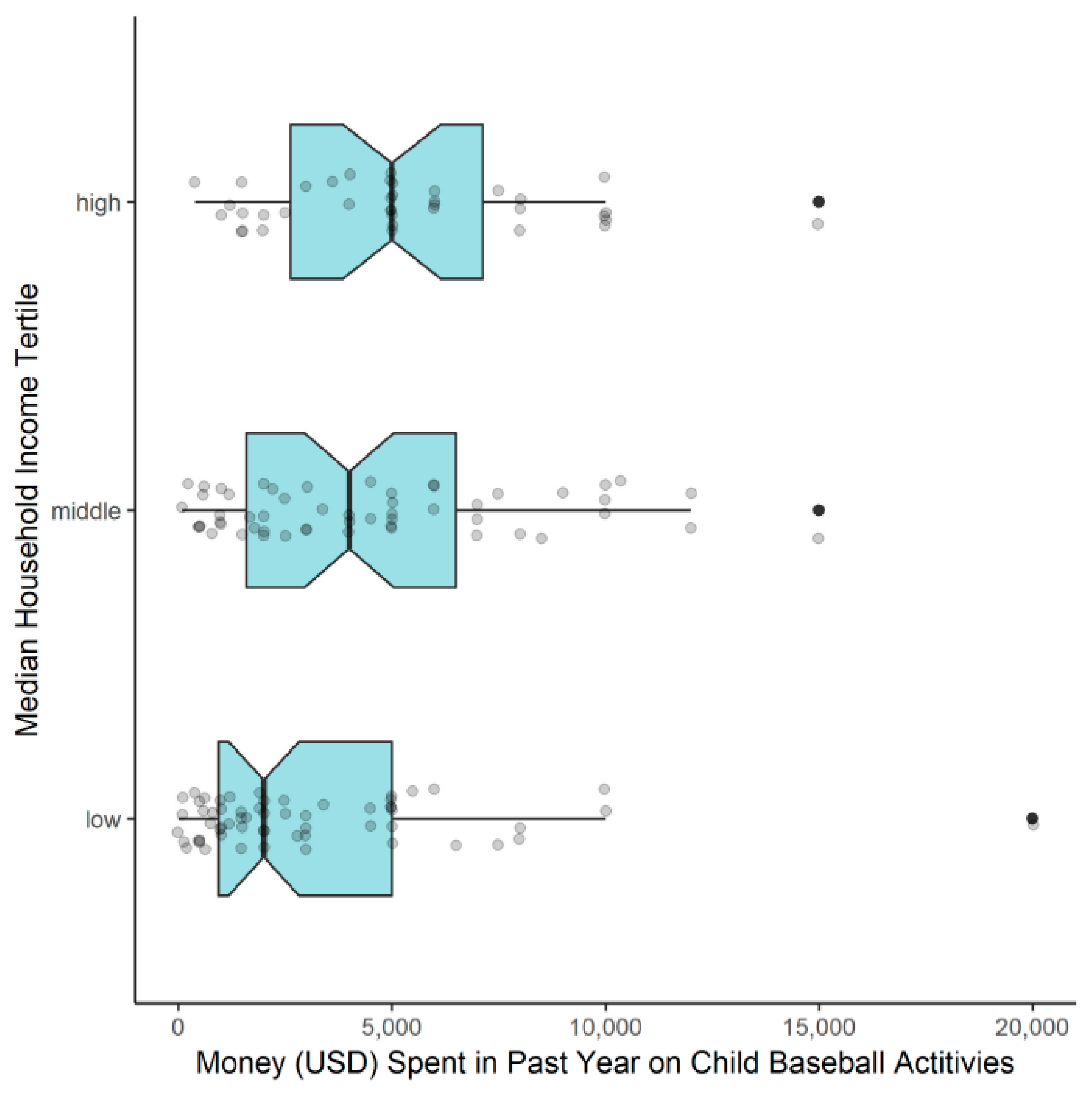Attitudes and Beliefs towards Sport Specialization, College Scholarships, and Financial Investment among High School Baseball Parents
Abstract
1. Introduction
2. Materials and Methods
2.1. Participants
2.2. Questionnaire
2.3. Statistical Analysis
3. Results
4. Discussion
5. Conclusions
Author Contributions
Funding
Conflicts of Interest
References
- High School Sports Participation Increases for 28th Straight Year Nears 8 Million Mark. Available online: https://www.nfhs.org/articles/high-school-sports-participation-increases-for-28th-straight-year-nears-8-million-mark/ (accessed on 16 February 2018).
- Erickson, B.J.; Nwachukwu, B.U.; Rosas, S.; Schairer, W.W.; McCormick, F.M.; Bach, B.R.; Bush-Joseph, C.A.; Romeo, A.A. Trends in medial ulnar collateral ligament reconstruction in the United States: A retrospective review of a large private-payer database from 2007 to 2011. Am. J. Sports Med. 2015, 43, 1770–1774. [Google Scholar] [CrossRef] [PubMed]
- Pitch Smart. Available online: https://www.mlb.com/pitch-smart/risk-factors (accessed on 6 August 2019).
- Bell, D.R.; Post, E.G.; Biese, K.; Bay, C.; Valovich McLeod, T. Sport Specialization and Risk of Overuse Injuries: A Systematic Review With Meta-analysis. Pediatrics 2018, 142, e20180657. [Google Scholar] [CrossRef] [PubMed]
- Jayanthi, N.A.; LaBella, C.R.; Fischer, D.; Pasulka, J.; Dugas, L.R. Sports-specialized intensive training and the risk of injury in young athletes: A clinical case-control study. Am. J. Sports Med. 2015, 43, 794–801. [Google Scholar] [CrossRef] [PubMed]
- Hall, R.; Barber Foss, K.; Hewett, T.E.; Myer, G.D. Sport specialization’s association with an increased risk of developing anterior knee pain in adolescent female athletes. J. Sport Rehabil. 2015, 24, 31–35. [Google Scholar] [CrossRef] [PubMed]
- Pytiak, A.V.; Stearns, P.; Bastrom, T.P.; Dwek, J.; Kruk, P.; Roocroft, J.H.; Pennock, A.T. Are the current little league pitching guidelines adequate? A single-season prospective MRI study. Orthop. J. Sports Med. 2017, 5, 1–7. [Google Scholar] [CrossRef] [PubMed]
- Brooks, M.A.; Post, E.G.; Trigsted, S.M.; Schaefer, D.A.; Wichman, D.M.; Watson, A.M.; McGuine, T.A.; Bell, D.R. Knowledge, Attitudes, and Beliefs of Youth Club Athletes Toward Sport Specialization and Sport Participation. Orthop. J. Sports Med. 2018, 6, 232596711876983. [Google Scholar] [CrossRef]
- Bell, D.R.; Post, E.G.; Trigsted, S.M.; Schaefer, D.A.; McGuine, T.A.; Brooks, M.A. Parents’ Awareness and Perceptions of Sport Specialization and Injury Prevention Recommendations. Clin. J. Sport Med. 2018, 00, 1–5. [Google Scholar] [CrossRef]
- Post, E.G.; Green, N.E.; Schaefer, D.A.; Trigsted, S.M.; Brooks, M.A.; Mcguine, T.A.; Watson, A.M.; Bell, D.R. Socioeconomic status of parents with children participating on youth club sport teams. Phys. Ther. Sport 2018, 32, 126–132. [Google Scholar] [CrossRef]
- Baseball: Probability of Competing Beyond High School. Available online: http://www.ncaa.org/about/resources/research/baseball-probability-competing-beyond-high-school (accessed on 4 August 2019).
- Post, E.G.; Trigsted, S.M.; Schaefer, D.A.; Cadmus-Bertram, L.A.; Watson, A.M.; McGuine, T.A.; Brooks, M.A.; Bell, D.R. Knowledge, Attitudes, and Beliefs of Youth Sports Coaches Regarding Sport Volume Recommendations and Sport Specialization. J. Strength Cond. Res. 2018, 1. [Google Scholar] [CrossRef]
- Glanz, K.; Rimer, B.; Lewis, F. Health Behavior and Health Education, 3rd ed.; Jossey-Bass: San Francisco, CA, USA, 2002. [Google Scholar]
- Rosenstock, I.M.; Strecher, V.J.; Becker, M.H. Social learning theory and the Health Belief Model. Health Educ. Q. 1988, 15, 175–183. [Google Scholar] [CrossRef]
- McGuine, T.A.; Post, E.G.; Hetzel, S.J.; Brooks, M.A.; Trigsted, S.; Bell, D.R. A Prospective Study on the Effect of Sport Specialization on Lower Extremity Injury Rates in High School Athletes. Am. J. Sports Med. 2017, 45, 2706–2712. [Google Scholar] [CrossRef] [PubMed]
- Norton, R.; Honstad, C.; Joshi, R.; Silvis, M.; Chinchilli, V.; Dhawan, A. Risk Factors for Elbow and Shoulder Injuries in Adolescent Baseball Players: A Systematic Review. Am. J. Sports Med. 2018, 47, 982–990. [Google Scholar] [CrossRef] [PubMed]
- Padaki, A.S.; Ahmad, C.S.; Hodgins, J.L.; Kovacevic, D.; Lynch, T.S.; Popkin, C.A. Quantifying Parental Influence on Youth Athlete Specialization: A Survey of Athletes’ Parents. Orthop. J. Sports Med. 2017, 5, 2325967117729147. [Google Scholar] [CrossRef] [PubMed]
- Ginsburg, R.D.; Steven, R.; Danforth, N.; Ceranoglu, T.A.; Durant, S.A.; Kamin, H.; Babcock, R.; Robin, L.; Masek, B. Patterns of Specialization in Professional Baseball Players. J. Clin. Sport Psychol. 2014, 8, 261–275. [Google Scholar] [CrossRef]
- Moesch, K.; Elbe, A.-M.; Hauge, M.-L.T.; Wikman, J.M. Late specialization: The key to success in centimeters, grams, or seconds (cgs) sports. Scand. J. Med. Sci. Sports 2011, 21, e282–e290. [Google Scholar] [CrossRef] [PubMed]
- Bridge, M.W.; Toms, M.R. The specialising or sampling debate: A retrospective analysis of adolescent sports participation in the UK. J. Sports Sci. 2013, 31, 87–96. [Google Scholar] [CrossRef] [PubMed]
- Post, E.G.; Thein-Nissenbaum, J.M.; Stiffler, M.R.; Brooks, M.A.; Bell, D.R.; Sanfilippo, J.L.; Trigsted, S.M.; Heiderscheit, B.C.; McGuine, T.A. High School Sport Specialization Patterns of Current Division I Athletes. Sports Health 2016, 9, 148–153. [Google Scholar] [CrossRef]
- Côté, J.; Lidor, R.; Hackfort, D. To Sample or to Specialize? Seven Postulates About Youth Sport Activities that lead to continued participation and elite performance. Int. J. Sport Exerc. Psychol. 2009, 9, 7–17. [Google Scholar] [CrossRef]
- Cote, J.; Vierimaa, M. The developmental model of sport participation: 15 years after its first conceptualization. Sci. Sports 2014, 29, S63–S69. [Google Scholar] [CrossRef]
- Long-Term Athlete Development Plan. Available online: http://www.sportdev.org/LTAD (accessed on 25 November 2019).
- Baxter-Jones, A.D.G.; Maffulli, N. Parental influence on sport participation in elite young athletes. J. Sports Med. Phys. Fit. 2003, 43, 250–255. [Google Scholar]
- Malina, R.M. Early sport specialization: Roots, effectiveness, risks. Curr. Sports Med. Rep. 2010, 9, 364–371. [Google Scholar] [CrossRef] [PubMed]
- Post, E.G.; Bell, D.R.; Trigsted, S.M.; Pfaller, A.Y.; Hetzel, S.J.; Brooks, M.A.; McGuine, T.A. Association of Competition Volume, Club Sports, and Sport Specialization With Sex and Lower Extremity Injury History in High School Athletes. Sports Health 2017, 45, 1941738117714160. [Google Scholar] [CrossRef] [PubMed]
- Bell, D.R.; Post, E.G.; Trigsted, S.M.; Hetzel, S.; McGuine, T.A.; Brooks, M.A. Prevalence of Sport Specialization in High School Athletics: A 1-Year Observational Study. Am. J. Sports Med. 2016, 44, 1469–1474. [Google Scholar] [CrossRef] [PubMed]
- Bell, D.R.; Post, E.G.; Trigsted, S.M.; Schaefer, D.A.; McGuine, T.A.; Watson, A.M.; Brooks, M.A. Sport Specialization Characteristics Between Rural and Suburban High School Athletes. Orthop. J. Sports Med. 2018, 6, 232596711775138. [Google Scholar] [CrossRef]
- Jayanthi, N.A.; Holt, D.B.; LaBella, C.R.; Dugas, L.R. Socioeconomic Factors for Sports Specialization and Injury in Youth Athletes. Sports Health 2018, 10, 303–310. [Google Scholar] [CrossRef]
- Post, E.G.; Trigsted, S.M.; Riekena, J.W.; Hetzel, S.; McGuine, T.A.; Brooks, M.A.; Bell, D.R. The Association of Sport Specialization and Training Volume With Injury History in Youth Athletes. Am. J. Sports Med. 2017, 45, 1405–1412. [Google Scholar] [CrossRef]



| Variable | N (%), Mean (SD), or Median [IQR] |
|---|---|
| Parent Sex | |
| Male | 73 (47.1%) |
| Female | 82 (52.9%) |
| Parent Age | 49.4 (5.5%) |
| Parent Race | |
| Asian | 8 (5.3%) |
| African American/Black | 0 (0%) |
| American Indian/Alaskan Native | 1 (0.7%) |
| Hispanic/Latino of any race | 18 (11.9%) |
| Native Hawaiian/other Pacific Islander | 0 (0%) |
| White/Caucasian | 119 (78.8%) |
| Two or more races | 5 (3.3%) |
| Parent Education | |
| Less than High School | 0 (0%) |
| High school diploma or GED | 26 (17.0%) |
| Associate or 2-year college degree | 14 (9.2%) |
| Bachelor or 4-year college degree | 66 (43.1%) |
| Graduate or professional degree | 47 (30.7%) |
| Parent Median Household Income (USD) | 99,250 [77,631–120,231] |
| Parent Median Household Income Tertile | |
| Low | 60 (39.0%) |
| Middle | 55 (35.7%) |
| High | 39 (25.3%) |
| Child Age | 15.8 (1.2) |
| Child Grade | |
| 9th | 58 (37.4%) |
| 10th | 41 (26.4%) |
| 11th | 26 (16.8%) |
| 12th | 30 (19.4%) |
| Variable | N (%), Mean (SD), or Median [IQR] |
|---|---|
| Total Number of Sports | 1.5 (0.6) |
| Baseball Start Age | 5 [4–6] |
| Years of Baseball Participation | 10.6 (2.0) |
| Months/Year of Organized Baseball | 11 [9–12] |
| Hours/Week of Organized Baseball | 12.3 (6.1) |
| Hours/Week of Unorganized Baseball | 2 [1–5] |
| Specialization * | |
| Low | 28 (18.3%) |
| Moderate | 52 (34.0%) |
| High | 73 (47.7%) |
| Club Baseball Team Participation | |
| Yes | 110 (71.0%) |
| No | 45 (29.0%) |
| Participate in Baseball > 8 months per year | |
| Yes | 119 (76.8%) |
| No | 36 (23.2%) |
| Hours/Week of Organized Baseball > Child Age | |
| Yes | 34 (21.9%) |
| No | 121 (78.1%) |
| Number of Overnight Trips in Previous Year | 2 [0–5] |
| Money Spent on Child’s Baseball in Previous Year (USD) | 3000 [1500–6000] |
| Baseball-Related Injury in Previous Year | |
| Yes | 51 (32.9%) |
| No | 104 (67.1%) |
| Question | Response N (%) | ||||
|---|---|---|---|---|---|
| Not at all | A little | Somewhat | Very | Extremely | |
| How concerned are you about the risk of injury in youth sports? | 18 (11.6%) | 34 (21.9%) | 59 (38.1%) | 37 (23.9%) | 7 (4.5%) |
| How much does focusing on one sport and playing that sport all year increase your child’s chances of | Not at all | A little | Somewhat | Quite a bit | A great deal |
| making a high school team? | 7 (4.5%) | 11 (7.1%) | 35 (22.6%) | 60 (38.7%) | 42 (27.1%) |
| making a college team? | 7 (4.5%) | 12 (7.8%) | 27 (17.7%) | 46 (30.1%) | 61 (39.9%) |
| getting injured? | 6 (3.9%) | 22 (14.4%) | 53 (34.6%) | 52 (34.0%) | 20 (13.1%) |
| getting better at baseball? | 1 (0.6%) | 8 (5.3%) | 22 (14.5%) | 53 (34.9%) | 68 (44.7%) |
| Not at all | A little | Somewhat | Quite a bit | A great deal | |
| How much of a problem do you think early sport specialization is in youth sports? | 17 (11.0%) | 17 (11.0%) | 44 (28.4%) | 42 (27.0%) | 35 (22.6%) |
| How Much do Each of the Following Reasons Limit Your Child’s Ability to Participate in Baseball? | |||||
|---|---|---|---|---|---|
| Not at all | A little | Somewhat | Quite a Bit | A Great Deal | |
| Cost (participation fees, equipment, coaching) | 72 (46.4%) | 43 (27.7%) | 24 (15.5%) | 10 (6.5%) | 6 (3.9%) |
| Time demands of baseball | 69 (44.8%) | 38 (24.7%) | 31 (20.1%) | 10 (6.5%) | 6 (3.9%) |
| Travel requirements for tournaments or showcases | 55 (35.5%) | 45 (29.0%) | 24 (15.5%) | 22 (14.2%) | 9 (5.8%) |
| Ability to transport your child to local practices or events | 91 (58.8%) | 38 (24.5%) | 20 (12.9%) | 3 (1.9%) | 3 (1.9%) |
| Time demands of other sports | 98 (63.2%) | 24 (15.5%) | 22 (14.2%) | 7 (4.5%) | 4 (2.6%) |
| Time demands of non-sport activities (work, church, school, etc.) | 37 (24.0%) | 55 (35.7%) | 38 (24.7%) | 20 (13.0%) | 4 (2.6%) |
| Family responsibilities | 52 (33.8%) | 53 (34.5%) | 41 (26.6%) | 7 (4.5%) | 1 (0.6%) |
| Computer or TV-based entertainment | 123 (79.4%) | 18 (11.6%) | 10 (6.5%) | 1 (0.6%) | 3 (1.9%) |
| Variable | Low MHI N (%) | Middle MHI N (%) | High MHI N (%) | X2 | p |
|---|---|---|---|---|---|
| Specialization | 11.6 | 0.02 | |||
| Low | 14 (23.3%) | 9 (16.7%) | 5 (13.2%) | ||
| Moderate | 27 (45.0%) | 17 (31.5%) | 8 (21.0%) | ||
| High | 19 (31.7%) | 28 (51.8%) | 25 (65.8%) | ||
| Club Baseball Participation | 7.7 | 0.02 | |||
| Yes | 35 (58.3%) | 42 (76.4%) | 32 (82.1%) | ||
| No | 25 (41.7%) | 13 (23.6%) | 7 (17.9%) | ||
| >8 months/year in baseball | 6.1 | 0.047 | |||
| Yes | 40 (66.7%) | 44 (80.0%) | 34 (87.2%) | ||
| No | 20 (33.3%) | 11 (20.0%) | 5 (12.8%) | ||
| Hours/week baseball > age | 1.8 | 0.42 | |||
| Yes | 16 (26.7%) | 12 (21.8%) | 6 (15.4%) | ||
| No | 44 (73.3%) | 43 (78.2%) | 33 (84.6%) |
© 2019 by the authors. Licensee MDPI, Basel, Switzerland. This article is an open access article distributed under the terms and conditions of the Creative Commons Attribution (CC BY) license (http://creativecommons.org/licenses/by/4.0/).
Share and Cite
Post, E.G.; Rosenthal, M.D.; Rauh, M.J. Attitudes and Beliefs towards Sport Specialization, College Scholarships, and Financial Investment among High School Baseball Parents. Sports 2019, 7, 247. https://doi.org/10.3390/sports7120247
Post EG, Rosenthal MD, Rauh MJ. Attitudes and Beliefs towards Sport Specialization, College Scholarships, and Financial Investment among High School Baseball Parents. Sports. 2019; 7(12):247. https://doi.org/10.3390/sports7120247
Chicago/Turabian StylePost, Eric G., Michael D. Rosenthal, and Mitchell J. Rauh. 2019. "Attitudes and Beliefs towards Sport Specialization, College Scholarships, and Financial Investment among High School Baseball Parents" Sports 7, no. 12: 247. https://doi.org/10.3390/sports7120247
APA StylePost, E. G., Rosenthal, M. D., & Rauh, M. J. (2019). Attitudes and Beliefs towards Sport Specialization, College Scholarships, and Financial Investment among High School Baseball Parents. Sports, 7(12), 247. https://doi.org/10.3390/sports7120247




